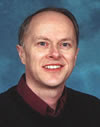
Familiarity is a useful quality, particularly when a song’s universal recognition permits a large crowd to rejoice as one, with a common energy and spirit. I think that that recurring experience is what I have come to cherish the most about my own church experience, as I reflect on the last 20+ years…remembering an almost angelic (?) lifting of song toward the heavens by the gathered…maybe even shaking the rafters! However, as I think about my latest ‘song scoop’, the tune’s pedigree almost defies the purpose of this blog. How can someone like me, a mere amateur music historian, discover something novel about a song like “Hallelujah, Praise Jehovah”? The song’s composer, William J. Kirkpatrick, is also a well-known figure, so my sleuthing skills are really challenged. If you, the reader-worshipper don’t mind, however, let’s re-dig the well a bit here, and re-appreciate what Kirkpatrick has given us.
William J. Kirkpatrick lived in 19th and early 20th Century Pennsylvania, and wrote “Hallelujah, Praise Jehovah” in 1893 after spending several decades as a musician in various capacities. He began to consider a career in music in the 1850s, and apparently learned to play the violin and cello, in addition to using his voice and his hand at composing. All these skills he used as part of the Wharton Street Methodist Episcopal Church in Philadelphia (you can read Kirkpatrick’s biography on the cyberhymnal site: http://www.cyberhymnal.org/bio/k/i/r/kirkpatrick_wj.htm). Kirkpatrick eventually published scores of hymns while taking part in choirs, singing societies, and special church programs, totally immersing himself in music. He was most certainly a worship minister before the term became fashionable!
William J. Kirkpatrick lived in 19th and early 20th Century Pennsylvania, and wrote “Hallelujah, Praise Jehovah” in 1893 after spending several decades as a musician in various capacities. He began to consider a career in music in the 1850s, and apparently learned to play the violin and cello, in addition to using his voice and his hand at composing. All these skills he used as part of the Wharton Street Methodist Episcopal Church in Philadelphia (you can read Kirkpatrick’s biography on the cyberhymnal site: http://www.cyberhymnal.org/bio/k/i/r/kirkpatrick_wj.htm). Kirkpatrick eventually published scores of hymns while taking part in choirs, singing societies, and special church programs, totally immersing himself in music. He was most certainly a worship minister before the term became fashionable!
Kirkpatrick’s diverse abilities shine through not only in the volume of his life’s accomplishments, but in the song we appreciate so much today, 116 years after it was written. We do not know the specific background to the song’s inspiration, but its message is not a mystery. God was magnificent to Kirkpatrick on many levels, as his words communicate in three verses. Kirkpatrick had already lived 55 years, and his composition exhibits a mature faith, appreciative of the blessing God represents not only to believers but also to us as this planet’s inhabitants. His words show he loved God for the variety of ways that we can relate to Him. Perhaps you’ve noticed this already, but allow me to conclude this scoop this way: Verse 1 reminds us that the Holy One is a celestial, heavenly king; Verse 2 tells us that God can unleash in His creation an awesome, terrifying power; Verse 3 makes us reflect upon the Lord’s creative, beautiful, life-giving nature. As I sing now, and let the words of Kirkpatrick’s words put to music flood my senses, I also reawaken my respect and fidelity to Jehovah.


